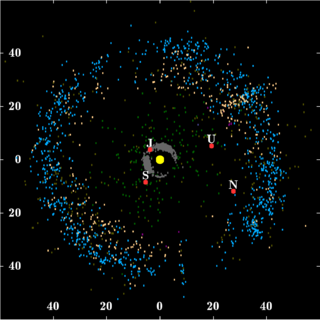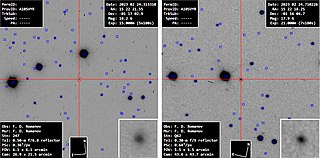
In planetary astronomy, a centaur is a small Solar System body that orbits the Sun between Jupiter and Neptune and crosses the orbits of one or more of the giant planets. Centaurs generally have unstable orbits because they cross or have crossed the orbits of the giant planets; almost all their orbits have dynamic lifetimes of only a few million years, but there is one known centaur, 514107 Kaʻepaokaʻawela, which may be in a stable orbit. Centaurs typically exhibit the characteristics of both asteroids and comets. They are named after the mythological centaurs that were a mixture of horse and human. Observational bias toward large objects makes determination of the total centaur population difficult. Estimates for the number of centaurs in the Solar System more than 1 km in diameter range from as low as 44,000 to more than 10,000,000.

4015 Wilson–Harrington is an active asteroid known both as comet 107P/Wilson–Harrington and as asteroid 4015 Wilson–Harrington. It passed 0.4 AU (60 million km) from Earth on 20 July 2022 and then passed perihelion on 24 August 2022. It seldom gets brighter than apparent magnitude 16. It will return to perihelion on 25 November 2026.
39P/Oterma is a currently inactive periodic comet with an orbital period of nearly 20 years that stays outside the orbit of Jupiter. The nucleus has a diameter around 4–5 km. It was last observed in August 2021 and came to perihelion in July 2023 while 1.2 AU from Jupiter. It will finish the modest approach to Jupiter in January 2025 and will next come to perihelion in July 2042 at distance of 5.9 AU from the Sun. Opposition has occurred on 11 November 2023.

60P/Tsuchinshan, also known as Tsuchinshan 2, is a periodic comet in the Solar System with an orbital period of 6.79 years. Tsuchinshan is the Wade-Giles transliteration corresponding to the pinyin Zĭjīn Shān, which is Mandarin Chinese for "Purple Mountain".

78P/Gehrels, also known as Gehrels 2, is a Jupiter-family periodic comet in the Solar System with a current orbital period of 7.22 years.
60558 Echeclus is a centaur, approximately 84 kilometers (52 miles) in diameter, located in the outer Solar System. It was discovered by Spacewatch in 2000 and initially classified as a minor planet with provisional designation 2000 EC98 (also written 2000 EC98). Research in 2001 by Rousselot and Petit at the Besançon observatory in France indicated that it was not a comet, but in December 2005 a cometary coma was detected. In early 2006 the Committee on Small Bodies Nomenclature (CSBN) gave it the cometary designation 174P/Echeclus. It last came to perihelion in April 2015, and was expected to reach about apparent magnitude 16.7 near opposition in September 2015.

11P/Tempel–Swift–LINEAR is a periodic Jupiter-family comet in the Solar System.

Comet Finlay is a periodic comet with an orbital period of 6 years discovered by William Henry Finlay on September 26, 1886. The next perihelion passage is July 13, 2021 when the comet will have a solar elongation of 54 degrees at approximately apparent magnitude 10. It last came to perihelion on December 27, 2014, at around magnitude 10. Of the numbered periodic comets, the orbit of 15P/Finlay has one of the smallest minimum orbit intersection distances with the orbit of Earth (E-MOID). In October 2060 the comet will pass about 5 million km from Earth.

166P/NEAT is a periodic comet and centaur in the outer Solar System. It was discovered by the Near Earth Asteroid Tracking (NEAT) project in 2001 and initially classified a comet with provisional designation P/2001 T4 (NEAT), as it was apparent from the discovery observations that the body exhibited a cometary coma. It is one of few known bodies with centaur-like orbits that display a coma, along with 60558 Echeclus, 2060 Chiron, 165P/LINEAR and 167P/CINEOS. It is also one of the reddest centaurs.
118401 LINEAR, provisional designation 1999 RE70, is an asteroid and main-belt comet (176P/LINEAR) that was discovered by the Lincoln Near-Earth Asteroid Research (LINEAR) 1-metre telescopes in Socorro, New Mexico on September 7, 1999. (118401) LINEAR was discovered to be cometary on November 26, 2005, by Henry H. Hsieh and David C. Jewitt as part of the Hawaii Trails project using the Gemini North 8-m telescope on Mauna Kea and was confirmed by the University of Hawaii's 2.2-m (88-in) telescope on December 24–27, 2005, and Gemini on December 29, 2005. Observations using the Spitzer Space Telescope have resulted in an estimate of 4.0±0.4 km for the diameter of (118401) LINEAR.

Comet Kopff or 22P/Kopff is a periodic comet in the Solar System. Discovered on August 23, 1906, it was named after August Kopff who discovered the comet. The comet was missed on its November 1912 return, but was recovered on its June 1919 return and has been seen at every apparition since. Close approaches to Jupiter in 1938 and 1943 decreased the perihelion distance and orbital period. 22P/Kopff’s last perihelion passage was 18 March 2022. On 13 July 2028 it will pass 0.353 AU (52.8 million km) from Earth.
(434620) 2005 VD, provisional designation 2005 VD, is a centaur and damocloid on a retrograde orbit from the outer Solar System, known for having the second most highly inclined orbit of any small Solar System body, behind 2013 LA2. It was the most highly inclined known object between 2005 and 2013. The unusual object measures approximately 6 kilometers in diameter.
163P/NEAT is a periodic comet discovered on November 5, 2004 by Near-Earth Asteroid Tracking (NEAT) using the 1.2 meter Samuel Oschin telescope at Palomar Observatory.

2012 DR30 is a trans-Neptunian object and centaur from the scattered disk and/or inner Oort cloud, located in the outermost region of the Solar System. The object with a highly eccentric orbit of 0.99 was first observed by astronomers with the Spacewatch program at Steward Observatory on 31 March 2009. It measures approximately 188 kilometers (120 miles) in diameter.

40P/Väisälä is a periodic comet that was discovered on February 8, 1939. Its orbit was determined on April 26, 1939. In 1994, the diameter of its nucleus was found to be 4.2 km, similar in size to that of Comet Encke.
2000 DG8 is a dark centaur and damocloid on a retrograde and highly eccentric orbit from the outer region of the Solar System. It was first observed on 25 February 2000, by astronomers with the LINEAR program at the Lincoln Lab's ETS near Socorro, New Mexico, United States. It has not been observed since 2001. The unusual object measures approximately 16 kilometers (9.9 miles) in diameter.
(606357) 2017 UV43 is a centaur from the outer Solar System, approximately 8 kilometers (5 miles) in diameter. It was discovered by the Mount Lemmon Survey on 13 March 2005. The unusual minor planet follows an orbit similar to those of the fragments of comet Shoemaker–Levy 9. This minor planet was numbered (606357) by the Minor Planet Center on 27 October 2021 (M.P.C. 136418). As of November 2021, it has not yet been named.
(468861) 2013 LU28, provisional designation 2013 LU28 is a highly eccentric trans-Neptunian object, retrograde centaur and damocloid from the outer regions of the Solar System. It was discovered on 8 June 2013 by astronomers with the Mount Lemmon Survey at the Mount Lemmon Observatory in Arizona, United States. The object is unlikely a dwarf planet as it measures approximately 110 kilometers (68 miles) in diameter. It was numbered in 2016 and has not been named since.
(523676) 2013 UL10 (prov. designation:2013 UL10) is a reddish centaur with cometary activity orbiting the Sun between Jupiter and Uranus. It was discovered on 18 August 2010, by a team of astronomers with the Pan-STARRS survey at the Haleakalā Observatory, Hawaii. It is the first centaur known to have both comet-like activity and red surface colors. It is also one of the smallest centaurs, with a nucleus of no more than 10 kilometers (6.2 miles) in diameter. As of 2021, it has not been named.

C/2023 A3 (Tsuchinshan–ATLAS) is a comet from the Oort cloud discovered by the Purple Mountain Observatory on 9 January 2023 and independently found by ATLAS South Africa on 22 February 2023. The comet will pass perihelion at a distance of 0.39 AU on 27 September 2024, when it could become visible to the naked eye. As of September 2023, the comet is currently 5.5 AU from the Sun, approaching at 17.9 km/s, with an uncertainty region of ±8,000 km.











